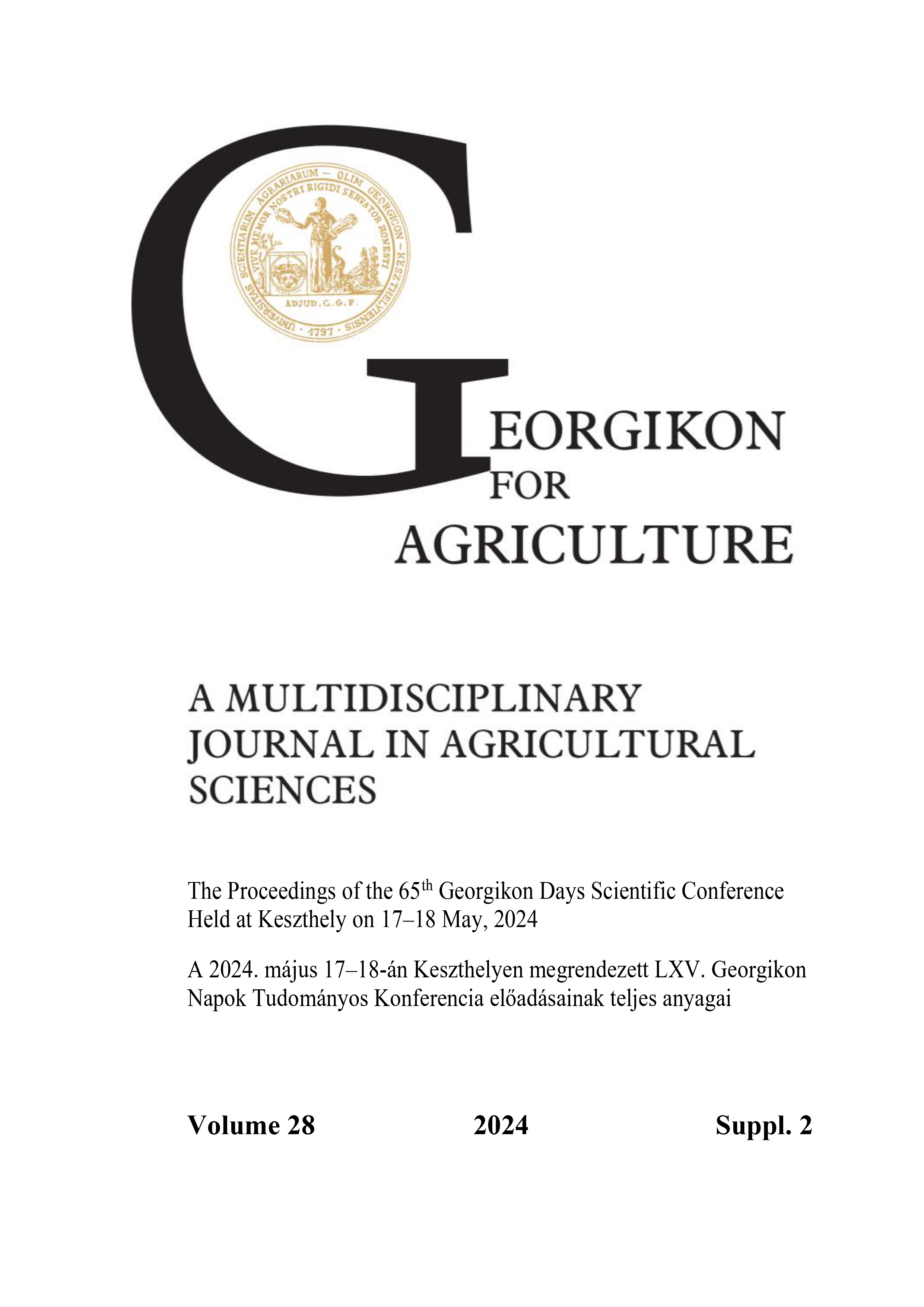A takarmánygyártás során használt expandálás és granulálás hatása a baromfi és sertés takarmánykeverékekre
Kulcsszavak:
vízben oldható rostok, vízben oldhatatlan rostok, takarmánygyártás, expandálás, granulálásAbsztrakt
A takarmánygyártás során különböző termikus és mechanikus kezeléseken esnek át a takarmánykeveréket alkotó takarmány alapanyagok, azonban a receptúrázáskor nem vesszük figyelembe ezen hatásokat, mint befolyásoló tényezőket. Kísérletünkben 19 db kereskedelmi takarmánykeveréket vizsgáltunk oldhatatlan (IDF), oldható (SDFP), neutrális detergens rost (NDF) vonatkozásában. Az üzemben a keverő után, az expander után, valamint a prés után történtek a mintavételek, így összesen 57 keveréktakarmány mintát vizsgáltunk. Analitikai módszerrel meghatároztuk a nyersrost mennyiségét, az IDF- és SDFP- tartalmat. Van Soest módszerrel vizsgáltuk a rostfrakciókat A gyártási technológia függvényében szignifikáns különbségek mutatkoztak IDF, SDFP, nyersrost tekintetében. Az összes takarmánykeverék IDF-tartalma dercés formában 13,24 % volt, mely szignifikánsan csökkent (P<0,05) 12 %-ra a granulátumban. Az összes takarmánykeverékre vonatkozó SDFP-tartalom a dercés keverékben 1,21 % volt, majd a granulátumban már, csak 0,94 % (P<0,01). Az összes takarmánykeverék figyelembevételével számított átlagos nyersrost-tartalom statisztikailag igazolható mértékben (P<0,05) különbözött a dercés keverék (4,44 %) és a granulátum között (4,52 %), továbbá az expandált keverék (4,46 %) és a granulátum (4,52 %) között. Az eredményekből arra következtettünk, hogy a termikus és mechanikus kezelések számottevően csökkentik az oldható és nem oldható rosttartalmat, melyet figyelembe kellene venni a receptúrázás során. Az oldható rosttartalom csökkenő tendenciája pozitívumként értékelhető, hiszen ezáltal a takarmány alapanyagokban lévő antinutritív hatás csökkenthető, ezáltal kedvezőbben alakulhat a takarmányértékesítés.
Hivatkozások
Abdollahi Mr. R., Ravindran V., Svihus B. 2013. Pelleting of broiler diets: An overview with emphasis on pellet quality and nutritional value. Animal Feed Science and Technology. 179 (1–4), 1–23.
Babinszky L., Halas V. (szerk.) 2019. Innovatív takarmányozás. Akadémiai Kiadó, Budapest, 995 p. https://doi.org/10.1556/9789634540571
Boroojeni F. G., Svihus B., Reichenbach H., Zentek J. 2016. The effects of hydrothermal processing on feed hygiene, nutrient availability, intestinal microbiota and morphology in poultry—A review. Animal Feed Schience and Technology, 220, 187–215. https://doi.org/10.1016/j.anifeedsci.2016.07.010
Chen T., Chen D., Tian G., Zheng P., Mao X., Yu J., He J., Huang Z., Luo Y., Luo J., Yu B. 2020. Effects of soluble and insoluble dietary fiber supplementation on growth performance, nutrient digestibility, intestinal microbe and barrier function in weaning piglet. Animal Feed Science and Technology. 260, 114335. https://doi.org/10.1016/j.anifeedsci.2019.114335
Erdélyi, I. 2007. Az expandálás hatása a pulykahizlaló takarmányok gyártásától felhasználásáig. Doktori disszertáció, Debreceni Egyetem Agrártudományi Centrum, Debrecen
Yavuz 2017. Heat applications in feed and food processing. Proceedings of 72nd The IRES International Conference, Mecca, Saudi Arabia 10 p.; 14 p.
Liu T., Zhen X., Lei H., Li J., Vang J., Gou D., Zhano J. 2024. Investigating the physicochemical characteristics and importance of insoluble dietary fiber extracted from legumes: An in-depth study on its biological functions. Food Chemistry: X, 22. 101424 https://doi.org/10.1016/j.fochx.2024.101424
Magyar Takarmánykódex 2004. Gazdasági állatok táplálóanyag–szükséglete, takarmányok kémiai összetétele és mikotoxin határértékek a takarmánykeverékekben (II–III. kötet) Budapest, OMMI
Megazyme 2013. Integrated Total dietary fiber. Megazyme International, 24 p.
Sarikhan M., Shahryar H. A., Gholizadeh B., Hosseinzadeh M., Beheshti B., Mahmoodnejad A. 2010. Effects of Insoluble Fiber on Growth Performance, Carcass Traits and Ileum Morphological Parameters on Broiler Chick Males. International Journal of Agriculture & Biology, 12 (4) 1560–8530.
Zhang W., Li D., Liu L., Zang J., Duan Q., Yang W., Zhang L 2013. The effects of dietary fiber level on nutrient digestibility in growing pigs. Journal of Animal Science and Biotechnology, 4 (17). https://doi.org/10.1186/2049-1891-4-17
Zhuo Y., Shi X., Lv G., Hua L., Zhou P., Che L., Fang Z., Lin Y., Xu S., Li J., Feng B., Wu D. 2017. Beneficial effects of dietary soluble fiber supplementation in replacement gilts: Pubertal onset and subsequent performance. Animal Reproduction Science 186, pp. 11–20. https://doi.org/10.1016/j.anireprosci.2017.08.007
Letöltések
Megjelent
Folyóirat szám
Rovat
License
Copyright (c) 2024 Brigitta Kiss, Márta Erdélyi, Nikoletta Such, Kesete Goitom Tewelde, Károly Dublecz

This work is licensed under a Creative Commons Attribution-NonCommercial-NoDerivatives 4.0 International License.
The articel is under the Creative Commons 4.0 standard licenc: CC-BY-NC-ND-4.0. Under the following terms: You must give appropriate credit, provide a link to the license, and indicate if changes were made. You may do so in any reasonable manner, but not in any way that suggests the licensor endorses you or your use. You may not use the material for commercial purposes. If you remix, transform, or build upon the material, you may not distribute the modified material. You may not apply legal terms or technological measures that legally restrict others from doing anything the license permits.




 Georgikon for Agriculture
Georgikon for Agriculture